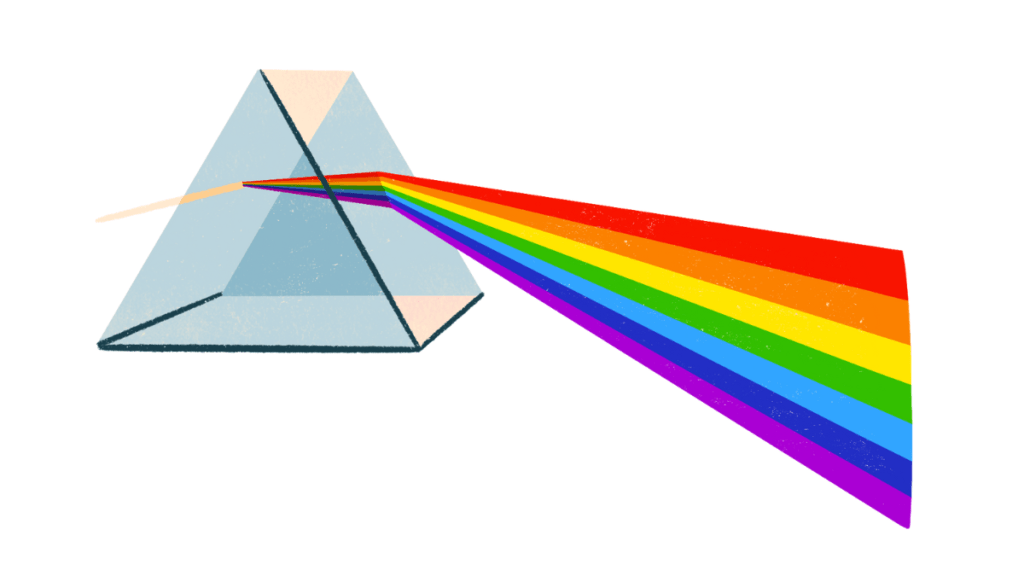This is an activity to collect information about the dispersion phenomenon that occurs in daily life.
What is Dispersion?
The splitting of white light into 7 different colours is called Dispersion. The seven different colours are abbreviated as VIBGYOR i.e., Violet, Indigo, Green, Yellow, Orange and Red.
Here red colour has the longest wavelength while violet colour has the shortest wavelength.
Dispersion Phenomenon in Daily Life
1. Rainbow:
The most common dispersion Phenomenon in our day-to-day life is Rainbow. The beautiful colours of the rainbow are due to the dispersion of the sunlight by millions of tiny water droplets. The rays of sunlight enter the drop near its top surface.
At this first refraction, the white light is dispersed into its spectrum of colours, violet being deviated the most and red the least. Reaching the opposite side of the drop, each colour is reflected back into the drop because of total internal reflection. Arriving at the surface of the drop, each colour is again refracted into the air.

At the second refraction, the angle between red and violet rays further increases when compared to the angle between those at the first refraction.
Although each drop disperses a full spectrum of colours, an observer is in a position to see only a single colour from any one drop depending upon its position.
2. Petrol spilled on Water:
From our childhood, we see dispersion in the water on the roads. And, you might have said to your friends look at the rainbow on the road. This happens when petrol spills on the water. Since Water and petrol are incompatible liquids. Because petrol is less dense than water, it tends to float on the ocean’s surface. When a light ray from the sun or another light source strikes an oil spill on the water’s surface, the dispersion phenomenon causes a pattern of coloured light to appear that is visible to the naked eye.
3. Soap Bubbles
The other one is of Soap Bubbles. We see this dispersion phenomenon in the soap bubbles too. This phenomenon will work like a rainbow formation only on the soap bubbles. When Light falls on the surface of the soap bubbles, it gets refracted and the whole concept of Rainbow formation works here, as we discussed above.
4. Plastic Scales:
One of the most obvious instances of everyday objects that might display the dispersion phenomena is a plastic ruler. A plastic ruler typically has a translucent appearance. Such a ruler tends to create a spectrum of light when held at a specific angle and exposed to white light. If the ruler is not coloured, the dispersion phenomena that were proved using plastic rulers perform better.
5. Compact Discs:
Compact disks or CDs are readable and writeable data storage devices. A multicolored pattern forms on the surface of a compact disk when it is held in your hand with the mirror face facing the source of light. A notable illustration of the dispersion phenomenon in practice is the presence or creation of this coloured pattern on the disk’s surface.

6. Prism
The last is a Prism. A prism is a piece of glass or silicon laboratory equipment that is typically used to show that the dispersion phenomena occur in reality. A white light ray splits into a spectrum of light as it contacts the surface of a prism. As a result, the output light has a tiny bending to it. The bending of light serves as a practical illustration of the phenomenon of light refraction.

Conclusion:
So, we see dispersion in our daily life in rainbow formation, in bubbles of soap, when petrol/oil spilled on water, in Prism and other things.
This activity has been taken from the class 10th Physics textbook and other online sources.
Suggested Projects:
- History Of Spherical Mirrors
- Corrosion of Iron
- Current Carrying Wires Produces Magnetic Fields
- Scientists who developed atomic theories
- Why do alcohols and glucose contain hydrogen but are not categorized as acids
- Experiment to Find Out Focal Length of a Lens
- Water of Crystallization Activity
- How do you select a good place to plant a tree?
- Experiment to find refractive index of Prism
- Different Types of Lenses for Correcting Eye Defects

